

Battery Basics for Climate Warriors – Watts Up With That? By Rud Istvan Got to thinking about WUWT 2.0, and some of the fact ammo climate skeptics here might need if/when Kerry becomes Biden’s climate guru.
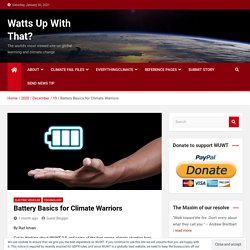
So here is a bit more WUWT fact ammo for the maybe coming renewed climate war. One of the BIG problems with renewables is their intermittency.
Grid Scale Battery Storage and Stabilization. Compressed/Liquified Air Energy Storage. Environmental Impacts of Battery Production, Use and Disposal. Energy Storage and Emissions. Energy Storage: Materials. Energy Storage Costs. Pumped Hydro Storage. Safety. Zero emissions, construction digger, runs out of power in 2 hours. Requiring it to be recharged using a diesel generator for 8 hours! Silly Jilly’s “Battery Boom” By Paul Homewood Silly Jilly has not got any better since she joined the Guardian: The UK risks being left behind in Europe’s home battery boom because of a controversial tax hike on solar-battery systems, according to a report.

The energy consultancy Wood Mackenzie has predicted that Europe’s home battery capacity could climb fivefold in the next five years as more households plug their rooftop solar panels into battery packs. The analysts expect that by 2024, annual home battery installations across Europe could total more than 500MW, the equivalent of building a new gas-fired power plant every year. The report said the battery boom had already taken hold in Germany and would accelerate across Italy and Spain as battery power became more economic. However, the UK is likely to lag behind its European neighbours due to its “unfavourable” policy frameworks and a VAT increase for solar-battery packs this October.
As usual though, she also gets thoroughly confused between CAPACITY and OUTPUT. This New Battery is a Game Changer. Lighter Cheaper More Powerful Battery Changes Renewable EconomicsGuest essay by Roger E.

Sowell, Esq. Marina del Rey, California It is not often on SLB that I use the phrase “game-changer.” Most things progress, if they progress at all, in small increments. Claim: Expensive Vanadium Flow Batteries will Make Renewable Energy Viable – Watts Up With That? Vanadium is expensive, though the price fluctuates wildly – currently $11K to $15K / tonne of Vanadium Pentoxide.
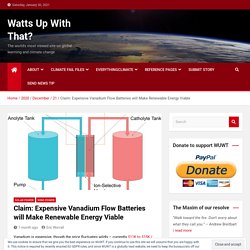
But advocates claim Vanadium flow batteries have the potential to solve the intermittency of renewable energy. Vanadium has an energy density of 15-25Wh / L, so to provide backup for a 1GW renewable plant for a day, you would need: 24 x 1GW = 24GWh of storage, or 24,000,000,000 Wh / 25 Wh / L = 960 million litres of Vanadium electrolyte – say a couple of billion dollars worth. An expensive battery, but not an unimaginable expense. Claim of new efficiency milestone in a new solar battery. From the OHIO STATE UNIVERSITY New design brings world’s first solar battery to performance milestoneSunlight makes the new ‘aqueous solar flow’ battery 20 percent more efficient than today’s lithium-iodine batteries COLUMBUS, Ohio–After debuting the world’s first solar air battery last fall, researchers at The Ohio State University have now reached a new milestone.
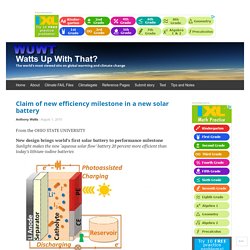
In the Journal of the American Chemical Society, they report that their patent-pending design–which combines a solar cell and a battery into a single device–now achieves a 20 percent energy savings over traditional lithium-iodine batteries. The 20 percent comes from sunlight, which is captured by a unique solar panel on top of the battery, explained Yiying Wu, professor of chemistry and biochemistry at Ohio State. The solar panel is now a solid sheet, rather than a mesh as in the previous design. Because water circulates inside it, the new design belongs to an emerging class of batteries called aqueous flow batteries. Abstract. Utility-Scale Energy Storage and Zinc-Air Batteries. Apparently, this company (EOS) has overcome the recharge limitation that exists in conventional zinc-air batteries, and supposedly has several patents on the technology.

If true, this technology would be a big boost for all sorts of battery powered technology, not just grid storage. The big question: what is the conversion efficiency? – Anthony Guest post by Mathias Aarre Mæhlum Illustration of Eos Aurora, the first zinc-air utility scale battery by Eos Energy Storage. In the next few years, an increasing amount of wind turbines and solar panels is expected to be built all around the world, reducing the stress that coal, fossil fuels and other polluting methods of harnessing energy does on our environment. There are several challenges related to the electrical grid we face when solar, wind and other renewable energy sources reaches 10, 15 and 20% of the total useful energy generated. Underwater Balloons – a new idea in Energy Storage? Author’s impression of an Underwater Balloon Energy Storage Facility Guest essay by Eric Worrall Hydrostor has created an interesting innovation in energy storage.
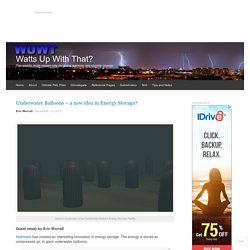
The energy is stored as compressed air, in giant underwater balloons. Hydrostor’s system works in several steps. Electricity is run through a compressor and converted into compressed air. Advances in research of electric car batteries presented at #AAAS. A number of interesting things have occurred at the AAAS meeting in San Jose the last few days, here is one that caught my eye.
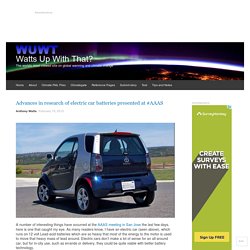
As many readers know, I have an electric car (seen above), which runs on 12 volt Lead-acid batteries which are so heavy that most of the energy to the motor is used to move that heavy mass of lead around. Electric cars don’t make a lot of sense for an all-around car, but for in-city use, such as errands or delivery, they could be quite viable with better battery technology. This newer Lithium-sulfur batteries show promise beyond the current favorite lithium-ion batteries due to their energy density and lighter weight: The current energy density of lead-acid batteries (not depicted on the chart) is around 60-100 Watt-hours per liter, well below all the others.
Let’s hope that they come to the market soon, not just for electric cars, but for many other applications that need high energy density and low weight. Claim: Let’s put batteries on wind and solar farms. From Stanford University Stanford scientists calculate the energy required to store wind and solar power on the grid Renewable energy holds the promise of reducing carbon dioxide emissions.

Study: Batteries Aren't Good Enough To Support Green Energy. Storing enough electricity in batteries to support wind and solar power faces enormous physical problems, which could make it economically impossible, according to a study published Tuesday by chemists at Texas A&M.

The study found that when electrons combine with the lithium ions in a battery, they distort the electronic structure of the device, essentially trapping unused energy in the battery, causing it to degrade rapidly. The research means that it may be inherently impossible to store large amounts of electricity cost effectively in a battery. “Fundamentally, when you have a battery, every time you use it, it starts to die a little bit,” Dr. Sarbajit Banerjee, a chemistry professor at Texas A&M, wrote in a press statement. “The more you use it, the more it dies. Going Solar: System Requirements For 100% U.S. Solar Generated Utility Baseload Electricity. By: Tom D. Tamarkin & Barrie Lawson Over the next 50 years, utility companies in the United States must replace approximately 440 Gigawatts (GW) of baseload generation capacity to provide electricity nationwide. Significant electrification of the transportation segment through electric cars and trucks can potentially quadruple the amount of needed power.
This paper explores the system requirements to replace this generation capacity with a photovoltaic only generation scheme. Topics include the definition of peak power demand, time of use issues, reserve power requirements, storage to provide power when there is no sunlight, and the various engineering challenges associated with managing a large area synchronous AC power grid. This analysis considers the factors involved in dimensioning solar power generating plants. South Australia – a Renewable State?
Hallet wind farm, South Australia Credit: Ian Sutton from Collinsville and Oberon, Australia Guest essay by Paul Miskelly and Tom Quirk With $90 billion spent on batteries and 4,000 MW of more wind farms, South Australia could be a totally renewable state, at least for electricity. South Australia along with one or two other states has been described by Al Gore as the canary in the coal mine for climate change and renewable energy. This interesting comparison was rewarded by South Australia putting the canary in the dark as there was no coal. But it would be interesting to see what the electricity supply of South Australia might be like with zero CO2 emissions as is the fond wish of many and even of learned societies.
There are many combinations of renewables that could be considered with wind, solar, biomass, pumped storage and various storage technologies. The starting point for this analysis is the dominance of wind power in South Australia. Another pie in the sky green scheme for using that excess atmospheric CO2. From the “there’s a shedload of carbon on the surface” department comes this “green solution” that will “overcome the environmental sins of our past”. Oy. Converting atmospheric carbon dioxide into batteriesA green solution for a global problem The Solar Thermal Electrochemical Process (STEP) converts atmospheric carbon dioxide into carbon nanotubes that can be used in advanced batteries. CREDIT Julie Turner, Vanderbilt University An interdisciplinary team of scientists has worked out a way to make electric vehicles that are not only carbon neutral, but carbon negative, capable of actually reducing the amount of atmospheric carbon dioxide as they operate.
They have done so by demonstrating how the graphite electrodes used in the lithium-ion batteries that power electric automobiles can be replaced with carbon material recovered from the atmosphere. In lithium-ion batteries, the nanotubes replace the carbon anode used in commercial batteries. Renewables Battery Research: The Government Funded Grant Eldorado. Guest essay by Eric Worrall Americas roads and infrastructure might be crumbling, but the US government still has plenty of money to spend on longshot research projects, to try to solve the intermittency of renewable power. Solar Energy Storage – A Gift from Gaia. Guest essay by Viv Forbes There is a massive problem with photo-voltaic solar power.
Modern cities and industries require power 24/7 but solar panels can only deliver significant energy from 9am to 3pm on a clear day – a maximum of 25% of the time. Even within this time, energy production peaks at midday and falls off steeply on either side. Science has yet to develop a solar storage battery suitable for grid power. It must be sufficiently large, cheap and efficient to hold the solar power generated during the short solar maximum so it can be used later, when peak demand usually occurs. Analysis: energy storage cannot solve the problem of intermittency of wind or solar power.